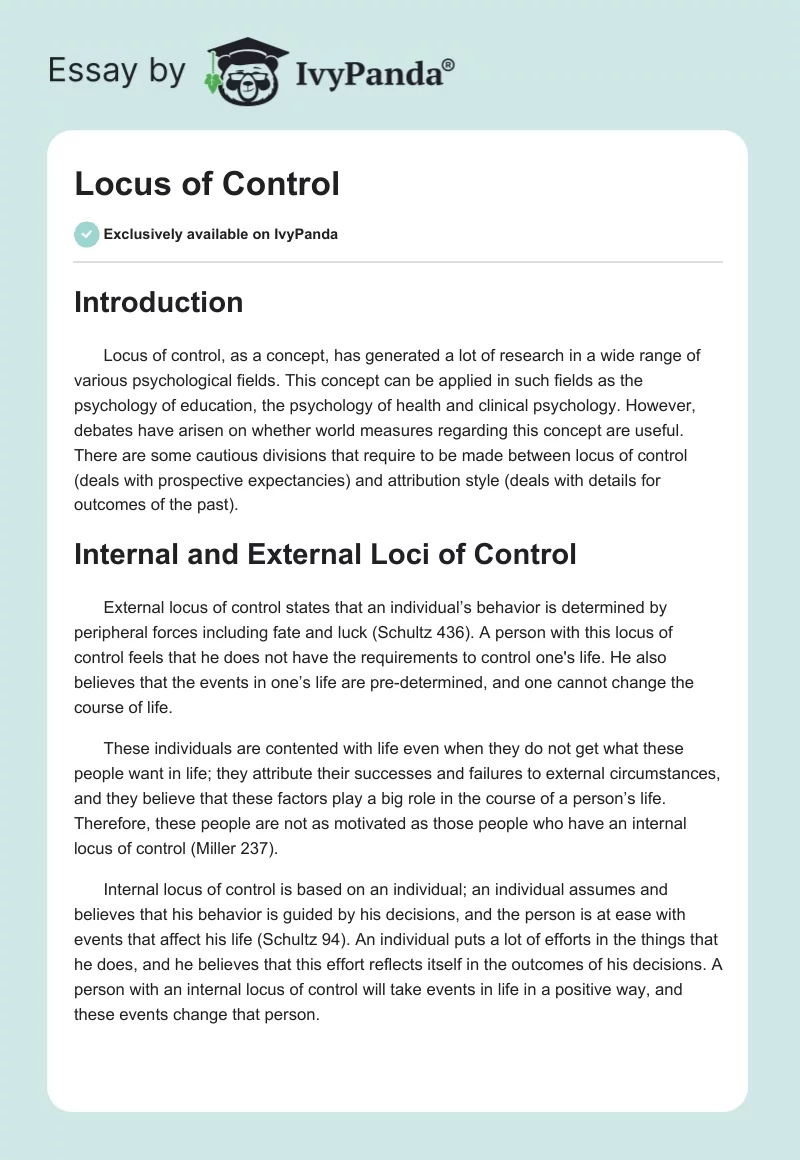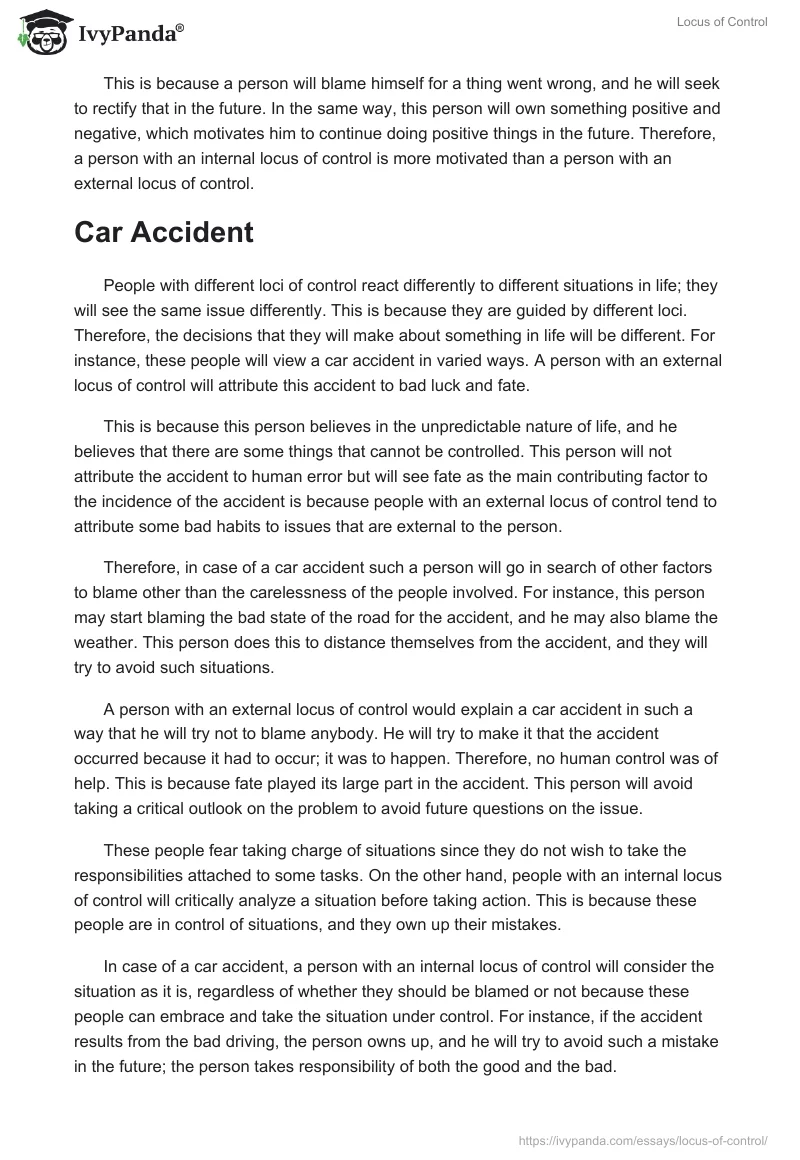Introduction
Locus of control, as a concept, has generated a lot of research in a wide range of various psychological fields. This concept can be applied in such fields as the psychology of education, the psychology of health and clinical psychology. However, debates have arisen on whether world measures regarding this concept are useful. There are some cautious divisions that require to be made between locus of control (deals with prospective expectancies) and attribution style (deals with details for outcomes of the past).
Internal and External Loci of Control
External locus of control states that an individual’s behavior is determined by peripheral forces including fate and luck (Schultz 436). A person with this locus of control feels that he does not have the requirements to control one’s life. He also believes that the events in one’s life are pre-determined, and one cannot change the course of life.
These individuals are contented with life even when they do not get what these people want in life; they attribute their successes and failures to external circumstances, and they believe that these factors play a big role in the course of a person’s life. Therefore, these people are not as motivated as those people who have an internal locus of control (Miller 237).
Internal locus of control is based on an individual; an individual assumes and believes that his behavior is guided by his decisions, and the person is at ease with events that affect his life (Schultz 94). An individual puts a lot of efforts in the things that he does, and he believes that this effort reflects itself in the outcomes of his decisions. A person with an internal locus of control will take events in life in a positive way, and these events change that person.
This is because a person will blame himself for a thing went wrong, and he will seek to rectify that in the future. In the same way, this person will own something positive and negative, which motivates him to continue doing positive things in the future. Therefore, a person with an internal locus of control is more motivated than a person with an external locus of control.
Car Accident
People with different loci of control react differently to different situations in life; they will see the same issue differently. This is because they are guided by different loci. Therefore, the decisions that they will make about something in life will be different. For instance, these people will view a car accident in varied ways. A person with an external locus of control will attribute this accident to bad luck and fate.
This is because this person believes in the unpredictable nature of life, and he believes that there are some things that cannot be controlled. This person will not attribute the accident to human error but will see fate as the main contributing factor to the incidence of the accident is because people with an external locus of control tend to attribute some bad habits to issues that are external to the person.
Therefore, in case of a car accident such a person will go in search of other factors to blame other than the carelessness of the people involved. For instance, this person may start blaming the bad state of the road for the accident, and he may also blame the weather. This person does this to distance themselves from the accident, and they will try to avoid such situations.
A person with an external locus of control would explain a car accident in such a way that he will try not to blame anybody. He will try to make it that the accident occurred because it had to occur; it was to happen. Therefore, no human control was of help. This is because fate played its large part in the accident. This person will avoid taking a critical outlook on the problem to avoid future questions on the issue.
These people fear taking charge of situations since they do not wish to take the responsibilities attached to some tasks. On the other hand, people with an internal locus of control will critically analyze a situation before taking action. This is because these people are in control of situations, and they own up their mistakes.
In case of a car accident, a person with an internal locus of control will consider the situation as it is, regardless of whether they should be blamed or not because these people can embrace and take the situation under control. For instance, if the accident results from the bad driving, the person owns up, and he will try to avoid such a mistake in the future; the person takes responsibility of both the good and the bad.
This person knows that he is reliable and dependable by most people, and so he will try to make his decisions for the good of all people (unlike a person with an external locus of control). Therefore, this will compel him to make decisions that will act for the good of all people. This person is not self-centered like the person using external locus of control, and he is intrinsically motivated to do good.
Therefore, if a car accident occurs, this person will give the full account from a personal point of view; good or bad. Therefore, the account of the accident, as told by a person with an internal locus of control, will be more comprehensive with helpful details than an account given by a person with an external locus of control.
External versus Internal loci
Despite the different opinions of people with different loci, each locus of control has its advantages and disadvantages. For instance, those who contain an external control locus are seen to be pleasant and humble. Therefore, this may make people believe in a person’s account of the car accident. However, over-reliance on external factors for behavior often leads people not to rely much on these people (Phares 79).
People with an internal locus of control are very responsible for whatever they do; good or bad. This makes these people influence other people in a big way. However, these people have a lot of ambition, and other people may view them as arrogant and unreasonable. Therefore, these people may have problems interacting with other people (Phares 79).
Conclusion
Both of these loci of control are important as they define different individuals in society. This creates a variety of people in society; all people are important to drive society forward. The associations of these people combine to create a diversified society that caters for all individual needs in a socially consistent manner.
Works Cited
Miller, Frederic. Locus of Control. New York: VDM Verlag Dr. Mueller e.K., 2010. Print.
Phares, Jerry. Locus of Control: A Personality Determinant of Behavior. New York: General Learning Press, 2005. Print.
Schultz. Duane. Theories of Personality. New York: Cengage Learning, 2005. Print.


